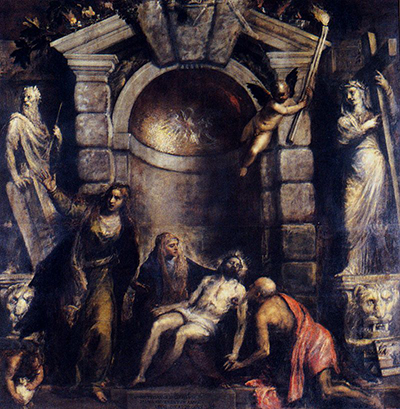Pieta is Titian's last painting, making it one of his most sentimental works.
Apparently, Titian makes an unusual personal confession through his last painting. This painting incorporates a self-portrait in the form of a bearded figure, the aging man gently holding the hand of the dead Christ. This painting is the last in a chain of self-portraits among which all have the Allegory of Time managed by Prudence in the National Gallery (1565- 1670).
Titian worked on the Pieta at a time when Venice was struck by a deadly plague. He painted it as an ex voto offering; a survival prayer for him and his favorite son Orazio. At the bottom of the painting’s right-hand side, supported under the stone lion, lies a tablet on which the painter and his beloved son are portrayed praying to the Virgin Mary for saving them from the marauding plague.
It is believed that his plea was never answered. Titian's death is recorded as having been caused by fever on August 27th, 1576. His son Orazio is also believed to have died during this particular plague.
In this masterpiece, the master of light plunges headlong into darkness, making death's night noticeable. Twinkles of hoary torch-besides moonlight upon mosaic shelter over Christ, on Moses and Sybil's statues, but above all the pale shining flesh Christ's body emphasises the horrible gloom; it’s irresistibly private.
The pure terror created by Titian makes the Christian images of redemption anything but cheering, with that fantastic gold flicker over the half-dome and the visionary figures, as well as the vegetation on the stone pediment. As much as the painting pleads for salvation, it comes with an emotional texture of fear and pure horror; the proximity of death. The stone represses the mind; the statues come across as frozen stone, just like a rigour mortis corpse; the painting's atmospheres is solidified, almost like the air was totally resentful.
It wouldn't go unnoticed that Titian offered this particular painting to the Church of Frari as a deal that would secure him a tomb in the church precincts. The maestro died with the painting still unfinished, this messed up the deal. This piece of work is the ultimate evidence that Titian was a believer. The painting is replete with hints of resurrection.
However, the sense of terror makes it nearly intolerable as Titian breathes his last. There is no doubt that his last painting was a huge influence on many in the world.
The history of European art can never be complete without several chapters on Titian's famous paintings. During his lifetime (1488-1576), his works spread far and wide. The famous painter’s fame spread its wings even wider and conquered further new territory after his death. During his time, Titian became the quintessential toast of many a monarch across the entire Europe. Interesting stories abound about his art; from the mythic scenes that are believed to have been commissioned by the Spanish court, to the golden-hue Danae that is said to have been stolen by Goering. However, Pieta is touted as one of his most famous works.
Titian mostly worked in Rome but would from time to time ensure that he touched base with Venice; the city that grew and nurtured him. The famous writer Pietro Aretino once referred to the revered painter as, "Our one and only." His exceptionality lies in his nearly numinous application of colour. Wherenas celebrated Florentine artists like Michelangelo could begin any of their paintings by drawing a figure, Titian is said to have executed most of his works by painting more freely, attaining a thick, luxuriantly textured surface through working on a coarse twill canvas, with a mysterious appreciation of light.
He was kind of a scientist and experimenter when it came to optical effects of colour associations and the manner in which people preserve visual memories. Titian experimented on his colours' brightness, in a very daring way, in his work of the Assumption altarpiece domiciled in the church of the Frari in Venice. This was a light-filled painting that was set against a huge window, harmonising natural light but at the same time competing with it. Artist Turner once quipped that the sun might be God, but when it comes to painting, Titian is.
Famous Depictions of Pieta by other Artists
Pieta by William-Adolphe Bouguereau




